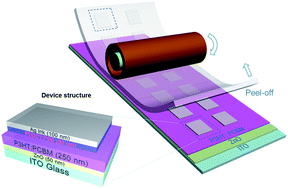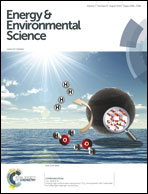Multi-film roll transferring (MRT) process using highly conductive and solution-processed silver solution for fully solution-processed polymer solar cells†
Abstract
To produce practical large area polymer solar cells (PSCs), it is highly desirable that the Ag (silver) top electrodes be made by a printing process rather than by vacuum evaporation. However, directly printing electrodes using highly conductive metal inks, such as organometallic and nanoparticle inks, has risks which can cause the infiltration and contamination of the underlying polymer layers during the printing and annealing processes. Moreover, the metal inks usually require high sintering temperatures to achieve high-conductivity electrodes. To overcome these limitations, we introduce a multi-layer roll transferring (MRT) approach, in which a high performance solution processed Ag electrode is prepared separately from the rest of the organic layers, and the device is completed by a final transferring process. By optimizing the processing conditions of the reductive organometallic Ag solution, the resulting metal electrode has an excellent resistivity (3.4 μΩ cm−1) and a morphology comparable to that of a thermally evaporated silver film. The performances of the devices fabricated by the MRT process were comparable to those of metal evaporated devices. Furthermore we achieved fully solution processed devices fabricated by integrating the roll-to-roll coating of the polymer cathode, polymer semiconductor and charge extraction layer and the MRT process.


 Please wait while we load your content...
Please wait while we load your content...